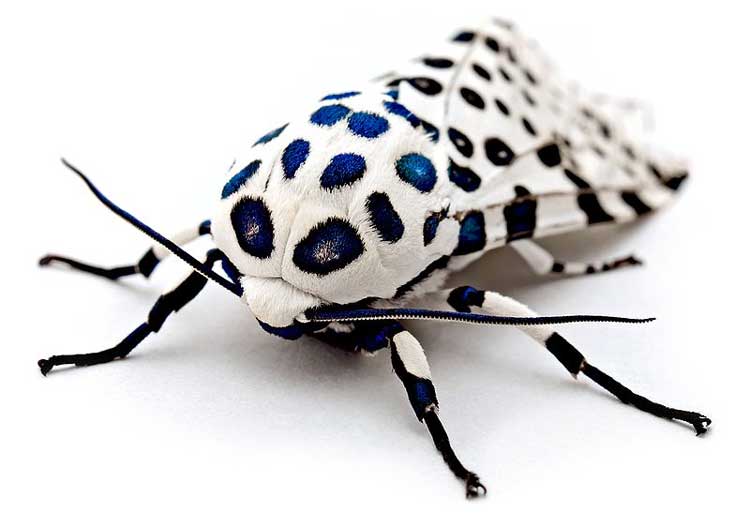
Hypercompe scribonia (*)
Superregnum: Eukaryota
Cladus: Unikonta
Cladus: Opisthokonta
Cladus: Holozoa
Regnum: Animalia
Subregnum: Eumetazoa
Cladus: Bilateria
Cladus: Nephrozoa
Cladus: Protostomia
Cladus: Ecdysozoa
Cladus: Panarthropoda
Phylum: Arthropoda
Subphylum: Hexapoda
Classis: Insecta
Cladus: Dicondylia
Subclassis: Pterygota
Cladus: Metapterygota
Infraclassis: Neoptera
Cladus: Eumetabola
Cladus: Endopterygota
Superordo: Panorpida
Cladus: Amphiesmenoptera
Ordo: Lepidoptera
Subordo: Glossata
Cladus: Coelolepida
Cladus: Myoglossata
Cladus: Neolepidoptera
Infraordo: Heteroneura
Cladus: Eulepidoptera
Cladus: Ditrysia
Cladus: Apoditrysia
Cladus: Obtectomera
Cladus: Macroheterocera
Superfamilia: Noctuoidea
Familia: Erebidae
Subfamilia: Arctiinae
Tribus: Arctiini
Subtribus: Spilosomina
Genus: Hypercompe
Species: Hypercompe scribonia
The giant leopard moth (Hypercompe scribonia) is a moth of the family Erebidae. They are distributed through North America from southern Ontario, and southern and eastern United States through New England, Mexico and south to Colombia.[2][3] The obsolete name, Ecpantheria scribonia, is still occasionally encountered.
This species has a wingspan of 76 mm (3 in). The wings of this moth are bright white with a pattern of neat black blotches, some solid and some hollow. The overside of the abdomen is dark blue with orange markings, while the underside is white with solid black spots, and males have a narrow yellow line on the sides. Their legs have black and white bands. Adult moths are strictly nocturnal and do not generally fly before nightfall.[4]
This species has a notable sexual dimorphism in size, the adult male reaching about 51 mm (2 in) in length, while the adult female grows up to 30 mm (1.2 in). In Missouri, adults are on the wing from May to September and are multivoltine.[5] During mating sessions, the wings of the male cover most of the female's abdomen, and this can sometimes lead to the loss of wing scales in the female, which can have negative effects on its flight efficiency.[6] Their mating sessions are notably long-lasting, taking more than 24 hours. They stay mostly immobile during the whole process but will move from spot to spot to thermoregulate, walking into shadowy areas if it is too hot or into sunlight if it is too cold. The male is the one that effectuates the locomotion, while the female folds her legs to make it easier to carry.
The caterpillar is of the "woolly bear" kind, with a thick coat of black bristles (setae) and red or orange bands between its segments, which become conspicuous when the caterpillar rolls into a ball for defense. Like the banded woolly bear, its hairs are not urticant nor venomous and do not typically cause irritation. The moth overwinters as a caterpillar,[3]often under the bark of decaying wood.[5] The caterpillar grows to be 3 inches (7.6 cm) long.[5]
Recorded food plants
This section does not cite any sources. Please help improve this section by adding citations to reliable sources. Unsourced material may be challenged and removed. (August 2022) (Learn how and when to remove this template message)
The caterpillar eats a variety of broadleaf plants such as broadleaf plantains, dandelions and violets:
Acer[5]
Bougainvillea
Brassica oleracea (cabbage)[5]
Brugmansia (angel trumpet)
Cannabis
Citrus
Dioscorea
Euphorbia
Helianthus (sunflower)[5]
Lagerstroemia (crepe myrtle)
Lactuca sativa (lettuce)[3]
Lonicera (honeysuckle)
Magnolia
Morus (mulberry tree)[3]
Musa (banana/plantain)[5]
Ocimum basilicum (basil)[3]
Paulownia (princess tree)
Persea
Phytolacca
Plantago
Prunus[5]
Pyrostegia
Ricinus
Robinia
Salix (willow)[5]
Syringa (lilac)
Taraxacum (dandelion)[5]
Viola[5]
References
Poole, Robert W.; Patricia Gentili (1996). "Hypercompe scribonia". NatureServe. Archived from the original on 10 December 2019. Retrieved 18 July 2013.
[1] Distribution map at DiscoverLife
Fearnley, Kirstin (29 July 2016). "Weird & Wonderful Creatures: Giant Leopard Moth". Science NetLinks. American Association for the Advancement of Science. Retrieved 5 September 2022.
Fullard, James H. & Napoleone, Nadia (2001). Diel flight periodicity and the evolution of auditory defences in the Macrolepidoptera. Animal Behaviour 62(2): 349–368. doi:10.1006/anbe.2001.1753 PDF fulltext Archived 15 June 2007 at the Wayback Machine
"Field Guide: Giant Leopard Moth". Missouri Department of Conservation. Retrieved 5 September 2022.
Scoble, M.J. (1995). The Lepidoptera: Form, Function and Diversity. Natural History Museum publications. Natural History Museum. p. 63. ISBN 978-0-19-854952-9.
Retrieved from "http://en.wikipedia.org/"
All text is available under the terms of the GNU Free Documentation License

